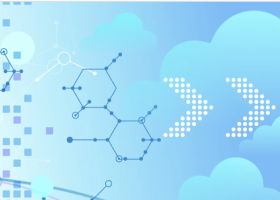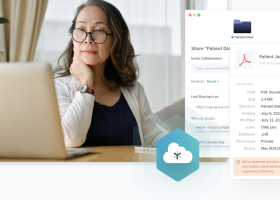Understanding Lab-to-Cloud Technology
Lab-to-cloud is the transition to or extension of traditional laboratory workflows, data, and applications from local, physical lab environments to cloud-based platforms. This shift to cloud labs involves leveraging cloud computing technologies to enhance the accessibility, scalability, and efficiency of data handling, analysis, and collaboration in scientific research and development environments.
By moving to the cloud, laboratories can overcome the limitations of physical infrastructure, such as space constraints, hardware maintenance, and scalability issues. This approach to lab management streamlines processes, making research and development work more efficient, scalable, and collaborative. It allows researchers and scientists to access their work from anywhere, share information more easily with colleagues around the world, and tap into advanced computing resources without the need for costly on-premises hardware.
Importance of Lab-to-Cloud in Scientific Research
Cloud labs represent a significant step forward for scientific research, with traditional laboratory processes and data management practices being enhanced and extended through lab-to-cloud technology. This integration allows for the virtualization of physical lab environments, enabling researchers to accelerate discovery and innovation. Cloud labs also democratize research with expanded access to high-powered computational resources. This makes it possible for smaller institutions and research teams to undertake complex projects that were previously beyond their reach due to hardware limitations.

Understanding Lab-to-Cloud Technology
At its core, cloud labs are the digitization and virtualization of laboratory processes and instruments, enabling researchers to conduct experiments, manage data, and collaborate in a digital space that is accessible from anywhere with an internet connection. Powered by cloud computing, this model provides access to shared computing resources, such as servers, high-performance computing (HPC) resources, storage, databases, networking, and software on demand.
All of these resources can be rapidly provisioned with minimal management effort. This integration is facilitated through advanced software platforms and Internet of Things (IoT) devices that connect laboratory equipment to the cloud, allowing for real-time data capture, analysis, and sharing.
Cloud Labs Data Security
Lab-to-cloud technology addresses some of the pressing challenges related to data security and compliance. Cloud providers offer robust security measures, including encryption, access controls (e.g., role-based access controls and multi-factor authentication), and security audits to ensure that sensitive research data is protected against unauthorized access and breaches. These data security controls also help cloud labs conform to research best practices and meet legal and ethical standards.
Data and Analytics in Cloud Labs
Data management and analysis are areas where cloud labs provide significant value. The scalable storage capacity and computational power of the cloud allow research teams to handle, store, organize, and share large volumes of complex data sets that are far beyond what traditional on-premises servers could manage.
Lab-to-cloud technology provides researchers with access to advanced analytical tools and computational resources that can significantly accelerate data analysis. Researchers can use artificial intelligence models, machine learning algorithms, statistical software, and custom analytics tools available in the cloud to process and analyze data more efficiently than traditional methods allow. These tools can handle complex computations and large datasets. The advanced analytics tools accessible in cloud labs enable researchers to uncover deeper insights, predict outcomes, and accelerate discovery at an unprecedented pace.
IoT in Cloud Labs
In cloud labs, laboratory instruments are connected to the cloud through IoT devices or directly through software solutions. Once connected, data generated by these instruments can be uploaded to the cloud automatically, where it is stored securely and made accessible for analysis. This setup not only streamlines data collection and management but also opens up new possibilities for real-time data analysis using advanced computational tools available in the cloud.
Remote Access and Control with Cloud Labs
Lab-to-cloud technology allows researchers to remotely access and control laboratory instruments and experiments via the internet. This capability is particularly beneficial for conducting experiments that require continuous monitoring or occur over extended periods.
Researchers can adjust experiments, observe results, and respond to data as it is generated in real time without being physically present in the lab, enhancing the flexibility and responsiveness of research projects. This not only maximizes the efficiency of research activities but also reduces the need for manual intervention, minimizing errors and enhancing reproducibility.
Significance of Lab-to-Cloud in Modern Scientific Research
The significance of lab-to-cloud is demonstrated by the benefits it brings to modern scientific research. The following are several of the many benefits the researchers and scientists find with cloud labs.
Efficient Data Management
Storing and managing large volumes of research data traditionally requires significant server capacity and IT support. Lab-to-cloud technology enables secure and scalable data storage in the cloud, often at a lower cost than physical storage solutions. Cloud providers also offer advanced data management tools. This eliminates the need for dedicated staff to manage research data.
Enhanced Productivity with Cloud Labs
Productivity gains are another significant advantage of cloud labs. Researchers can design, execute, and monitor multiple experiments simultaneously. Cloud labs also allow experiments to be automatically run overnight or during other downtimes. This increased efficiency means that more research can be done in less time, leading to faster advancements and discoveries.
Energy and Space Savings with Cloud Labs
Maintaining on-premises data centers and laboratory equipment can be energy-intensive and require significant physical space. By transitioning to cloud labs, research institutions can reduce their energy consumption and free up valuable space for other uses.
Improved Data Management and Integrity with Lab-to-Cloud Technology
Lab-to-cloud technology also offers a more systematic approach to data management and integrity. With features such as direct data capture (DDC), lab-to-cloud technology makes it possible to automatically record all data associated with an experiment, ensuring accuracy, traceability, and compliance with regulatory standards. This level of data management helps research teams maintain the quality and reliability of scientific research outcomes.
Minimized Infrastructure Costs
By leveraging lab-to-cloud technology, research organizations can minimize their investment in expensive on-site IT infrastructure. A cloud lab approach offers scalable computing resources, eliminating the need for extensive hardware purchases and maintenance. Moving from capital expenditure to operational expenditure also allows cloud labs to pay only for the computing resources they use when they use them.
Modern Scientific Research with Lab-to-Cloud Technology
Lab-to-cloud technology allows complex experiments to be conducted remotely. This capability not only broadens the scope of scientific research but also makes it more accessible to researchers worldwide, regardless of their physical location or the limitations of their local infrastructure.
With cloud labs, scientists are able to advance their research more quickly, as they can utilize high-performance computing resources and advanced analytical tools available in the cloud. In addition, automating routine tasks reduces the time required for data analysis and experiment runs, leading to faster research cycles.
Optimized Communication and Workflow Integration
Lab-to-cloud platforms often include integrated communication tools and project management features that facilitate smoother collaboration among research teams. These tools often include messaging systems, video conferencing, shared calendars, and project-tracking software to improve coordination and efficiency. Additionally, workflow integration features allow for the automation of routine tasks and the establishment of standardized protocols, further streamlining the research process.
Reduced Software Costs with Lab-to-Cloud Technology
Cloud platforms offer access to a wide range of software tools and applications necessary for data analysis and research. By utilizing these cloud-based applications, institutions can avoid the costs associated with purchasing individual software licenses and managing software updates.
Scalability and Flexibility of Cloud Labs
Lab-to-cloud technology provides the flexibility to scale computing resources up or down based on the project’s needs without significant capital investment in physical infrastructure, avoiding overprovisioning and underutilization. This flexibility allows research projects to adapt quickly to changing requirements without financial penalties. Cloud labs’ scalability also ensures that projects of any size can be accommodated, from small-scale studies to massive data-intensive projects, making cutting-edge research more accessible to institutions of all sizes.
Streamlined Compliance
Cloud service providers implement robust security measures and comply with various regulatory standards, ensuring that sensitive research data is protected against breaches and loss. This helps streamline adherence to requirements for compliance with regulatory standards, such as those set forth by the Health Insurance Portability and Accountability Act (HIPAA), General Data Protection Regulation (GDPR), and other laws and regulations covering good clinical practice (GCP)regulations and best practices.
Unprecedented Collaboration with Cloud Labs
Cloud labs facilitate unprecedented levels of collaboration and data sharing among scientists. The ability to design experiments, share data and methodologies, conduct analysis, and share results in real-time from anywhere in the world securely and efficiently.
Cloud labs also support projects that require multidisciplinary expertise or are spread across different geographical locations. This collaborative framework not only speeds up the research process but also fosters a more inclusive and diverse research environment and scientific community where knowledge and resources are shared openly.
Implementing Lab-to-Cloud Technology
Setting up cloud labs is a strategic process that involves integrating traditional laboratory operations with cloud-based computing resources. This transition not only enhances data accessibility and collaboration but also streamlines research workflows. The following are the key steps for implementing lab-to-cloud technology effectively.
Assess needs and set objectives
Start by evaluating the organization’s specific needs and determining what benefits will be realized with lab-to-cloud technology. Also, identify key objectives such as improving data accessibility, enhancing collaboration, or streamlining data management and analysis. This initial assessment will guide the selection of appropriate services and technologies for cloud labs.
Choose the right cloud provider
There are many options for providers to support cloud labs. The right cloud provider will align with the cloud lab’s specific requirements. When evaluating cloud lab providers, be sure to consider their capabilities and track record around data security, compliance with regulatory standards (e.g., HIPAA, GDPR, and GCP), and the availability of specific tools and applications necessary for the research. Also, assess the provider’s scalability, reliability, and customer support services.
Plan for data migration
Develop a detailed plan for migrating existing laboratory data to the cloud lab. This involves identifying which data sets need to be moved, determining the format and structure in which data will be stored in the cloud, and establishing a timeline for the migration process. In some cases, leveraging data management professionals or consulting services can help streamline the process and minimize errors to ensure a smooth transition.
Integrate laboratory instruments with the cloud
Connect laboratory instruments and equipment to the cloud using IoT devices or direct software integration. This step may require technical adjustments or upgrades to existing equipment to enable remote monitoring and control. Be sure to establish secure connections for all devices to ensure data privacy and integrity during transmission.
Implement security measures
Implement robust security measures, including encryption, access controls (e.g., role-based access controls or attribute-based access controls), and multi-factor authentication to protect sensitive research data. Also, defend against emerging threats and ensure compliance with data protection requirements dictated by regulations by assessing software and security protocols on an ongoing basis.
Train staff and researchers
Ensure that all personnel involved in laboratory operations are trained on the new lab-to-cloud technology. This includes training on data management practices, security protocols, and the use of cloud lab tools and applications.
Establish collaboration protocols
Define protocols for collaboration and secure data sharing within the cloud lab environment. This includes setting up permission levels for data access, establishing procedures for data sharing among collaborators, and implementing tools for communication and project management.
Monitor and optimize cloud lab operations
Once the lab-to-cloud system is operational, continuously monitor its performance and user adoption. Collect feedback from researchers and technical staff to identify areas for improvement. Use this input to optimize the cloud lab systems to enhance functionality, user experience, and operational efficiency.
Review and update regularly
Lab-to-cloud technology and cloud computing resources evolve rapidly. Regularly review cloud lab systems to ensure they remain aligned with the organization’s research objectives and incorporate the latest technological advancements. This may involve updating software tools, expanding cloud storage capacity, or enhancing security measures.
Cloud Labs Represent Major Shift for Research and Development
The shift to lab-to-cloud is a pivotal development in scientific research, offering enhanced efficiency, scalability, collaboration, and data management. It accelerates scientific discoveries and innovations, making the future of scientific research and development more dynamic, efficient, scalable, and collaborative. By harnessing the power of cloud labs, researchers are pushing the boundaries of discovery making significant advancements in science and technology.
Egnyte has experts ready to answer your questions. For more than a decade, Egnyte has helped more than 17,000+ customers with millions of users worldwide.
Last Updated: 8th July, 2024


